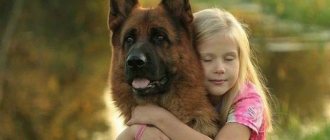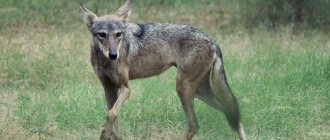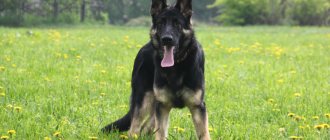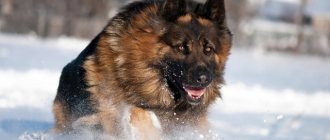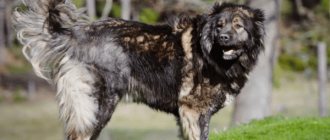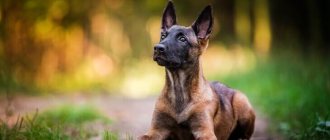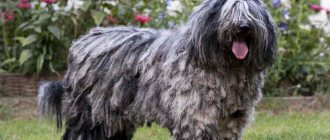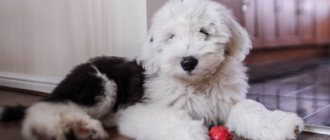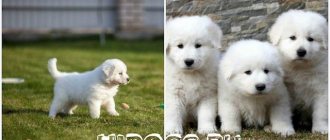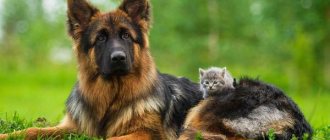History of the origin of the species
The breed appeared by accidental crossing of herding dogs and the Belgian Shepherd. The word "herder" translates as "shepherd", hence the use of specimens. Representatives of this species became known in the first half of the 18th century. However, the breed was officially recognized on June 12, 1898 at an exhibition in Arnhem. After the exhibition, amateur clubs began to appear.
Herder, the oldest breed and a true friend
Important! The standard of this species is the oldest and has only been changed twice, which is rare.
Unfortunately, the Herder is a dog that has not become very popular, since it was competed by the German Shepherd. With the disappearance of flocks of sheep, dogs began to be used as pets, and in the 20th century Holland began to accept them for police service. Currently, the Dutch Shepherd is considered a rare breed. No more than 300 puppies are born annually, and most of them remain in the Lower Netherlands.
Puppies first appeared in the Russian Federation in 2013. However, there are no more than 10 breeders in Russia, so meeting these individuals is not so easy.
Exterior of the Dutch Shepherd
Video "Dutch Shepherd"
From this video you will learn everything about the Dutch Shepherd.
Recommended Posts
Standard height and weight of the Cane Corso breed by month
Weight of a puppy and an adult Labrador by month
Weight and height of a German Shepherd puppy by month
TOP 40 best hunting dog breeds with names, descriptions and photos
38 best dog breeds for apartments according to reviews from breeders and owners
The best hunting helpers: TOP-30 hound dog breeds with names and photos
Appearance - color and size
Maremma Abruzzese Shepherd: description of the Italian breed
There are three varieties of the breed:
- shorthair;
- long-haired;
- Wire-haired.
The first and second species have the same coat color - yellowish or silver with black stripes. The latter has a gray-blue color. Long-haired representatives are a rare species, since they are completely unsuitable as a herding dog.
Individuals of this species are large but lightweight dogs. Their height reaches 60 cm, and body weight up to 26 kg. Externally, the dog is proportional, even in size, the chest is narrow, the limbs are light, but they are strong. The head is wedge-shaped, the skull is somewhat shorter than the muzzle.
Description and appearance of the Dutch Shepherd
The Dutch Shepherd looks like a wolf, has a strong physique, well-developed muscles, the height of a male reaches 57-62 cm, females - 55-60 cm, their weight ranges from 23-30 kg.
The head is medium in size, proportional to the body, the muzzle is elongated, with a smooth transition from the forehead. The ears are large, triangular, set vertically, and slightly tilted back. The eyes are almond-shaped, the iris is dark. The jaws are developed, grasping, with a scissor-type bite. The body is dense, the back is level, the chest is deep, with oval ribs. The limbs are strong, elongated, with strong bones, paws with arched toes, gathered into a ball. The tail is long, slightly curling to the side.
Individuals are divided into:
Take the Attention Test! Find 10 differences! (click right here!)
Find the answer Are you bothered by some problem or question? Enter “Breed” or “Name of the problem” into the form, press Enter and you will find out everything about the issue that interests you.
- long-haired;
- shorthaired;
- Wire-haired.
Long-haired Herders are considered rare, their color is black, and there may be some graying.
The color of individuals with short and coarse hair is not uniform; it can be golden-brown, variegated-tiger. Short-haired dogs are the most common.
A visual representation of the breed standard can be obtained at exhibitions organized by professional breeders.
Character and behavioral characteristics
The Dutch Shepherd is an active, cheerful and physically developed species that has a balanced temperament. She is a true friend in the family, loving both adults and little family members equally. However, she recognizes only one person as the owner, to whom she is devoted.
Groenendael (dog breed), Belgian Shepherd: description of the breed
The behavior of the Herder is easily controlled by the owner, because he is obedient, never attacks without a reason and has no tendency to run away. The territory, which it considers to be its own, is carefully protected from outsiders, therefore it is considered a good watchman. Also distinguished by vigilance, self-confidence, fearlessness and intelligence.
Important! When walking, he tries to keep his owner in sight and never runs away from him at a great distance.
The dog has a hard time withstanding loneliness and may be offended by his owner for leaving him alone for a long time. In addition, such a pet, like the Scottish Sheepdog, only speaks when necessary, so it will be an indispensable friend for a family with children.
Shorthaired Herder is the best territory guard
Character and intelligence
Breeders note the following character traits in Herders:
- activity;
- cheerfulness;
- devotion;
- high degree of obedience;
- the need to communicate with a person.
The Dutch Shepherd can attract attention by jumping on its owner, trying to jump up to the face and lick it.
Attitude towards children and others
The Dutch Shepherd (Herder) treats its owner with love and devotion. In relation to other family members, the dog is affectionate and shows tenderness. He treats children with care and patience, protecting them from potential danger.
The dog's attitude towards strangers is wary, however, without expressed aggression. Safe for others if they do not encroach on his home or threaten the lives of family members. Security qualities in a dog are inherent at the genetic level.
If a shepherd dog actively interacts with other dogs during training, then during walks it does not show aggression towards them. The pet will not act as the instigator in a fight.
Education and training
Raising a Herder is a real pleasure, because the dog is attentive and easily learns the technique of following a command. The Dutch Shepherd learns quickly and happily follows commands, expecting praise from its owner.
Mongolian Shepherd Bankhar: description of the breed
However, a harsh method of education is not suitable for such individuals, because they are very touchy and can refuse to follow a command or even run away from an owner who is prone to violence. It is best to carry out training in a playful way, rewarding the pet for correctly completing the task.
Interesting! The Dutch Shepherd needs to feel needed by people, which is why they are used not only in police service, but also as therapy in nursing homes.
Education will be easier if the person manages to build a trusting relationship with the dog. When kept on private property, it is not recommended to chain such a shepherd, nor is it recommended to lock it in rooms.
Training your pet yourself
Purpose
Initially, the breed was bred as a herding breed. For a long time they were used exclusively for their intended purpose. Over time, the Herder began to be trained as a watchdog, since it has all the qualities characteristic of the “Shepherd” section. Nowadays, dogs of this variety are successfully used as shepherds, as guard dogs, and as a guide dog.
Grooming
Dogs have a thick undercoat that requires careful grooming. For this purpose, it is necessary to comb your pet at least once a week, and even more often for a long-haired representative. During the molting period, it is best for the owner to acquire a furminator in order to avoid the accumulation of hair on the furniture.
Since the fur does not grow back well, cutting representatives of this breed is prohibited. It should be washed without using shampoo and as rarely as possible, and it is best to clean it with a damp cloth.
The Dutch Wirehaired Shepherd requires trimming twice a year. This will remove dead hairs that bother the dog.
A well-organized walk with your pet near a pond
How to position the ears
It is not always the case that a pet’s ears automatically take on the “upright” position; sometimes the owner has to apply force to achieve this. So, to set up the ears you will need:
- ice cream sticks;
- patch;
- soft curlers.
Before starting the process, you need to prepare the ears, namely treat them with peroxide or alcohol-based lotion, but the liquid should not get inside the ear. Using a patch, you need to attach the stick to the base of the ear, securing the jumper between them.
Jumpers and sticks need to be changed several times a week, especially if they get wet. Using this method, your pet's ears stand up in 3-4 weeks.
Health and susceptibility to disease
Herders can boast of excellent health, so the breeder will not have to treat the dog for colds, allergies or stomach diseases. In addition, according to the genetic line, dogs also do not have problems. The lifespan of a four-legged pet is about 15 years.
However, individuals of this species are susceptible to certain diseases:
- hip dysplasia;
- arthritis;
- cataract.
Important! Adult dogs are required to be vaccinated. After the procedure, quarantine is not required.
Pros and cons of the breed
Like any breed, the Dutch Shepherd has its pros and cons, the description of which deserves special attention. Among the positive aspects are the following:
- These dogs have excellent watchdog qualities.
- Herder is the best companion and reliable friend who will protect his owner to the last.
- The breed is distinguished by excellent endurance and courage.
- These dogs are highly trainable and intelligent.
- Herders rarely get sick and have good immunity.
Active walking for an active dog
Negative sides:
- Inconspicuous exterior.
- The dog constantly needs company. Being alone in an apartment or on a property all day is unbearable for her.
- The dog is safe for families with small children. But he will not hang out with them until they reach an age when they can play with him.
- Herder does not like strangers on his territory. Moreover, even as a puppy, this side manifests itself and becomes more noticeable with age. Even with a dog of the same breed, with age, living together in the same territory ends in conflicts.
The characteristics of this breed, although it has its pros and cons, are still a loyal friend and a reliable protector, so purchasing such a pet would be the best decision.
Training
Like all representatives of shepherd dogs, the Herder is perfectly trainable. It is better to start from puppyhood. People involved in breeding the breed introduce babies to the basics of training during the first feedings from a bowl. From the age of one month, it is worth starting to instill in your dog the concept of “places”, basic commands:
- ugh;
- it is forbidden;
- to me;
- sit;
- lie.
In the future, this will greatly simplify communication with the dog and control of the pet during walks. Despite the herder's purpose as a herder, unlike the chapendus, it is quite possible to train it as a watchdog. They are not aggressive, but they have the concept of their territory, which they are ready to defend.
Note! The use of corporal punishment is not recommended in training. Herders respond well to the voice and its intonations, remember why they are praised and given treats. It is this approach to education that will help raise an obedient and faithful dog.
How much do they cost and where to buy
Considering that the breed, like the Lapland Sheepdog, is rare and the annual number of puppies does not exceed three hundred, the price for them is appropriate. In the Netherlands, the price tag ranges from 500 to 700 euros*, and in Russia it is about 40,000 rubles. The final cost is influenced by the title of the puppy's parents.
Movable herder in nature
You can buy a faithful four-legged friend from a breeder or at a dog kennel. However, finding it may be difficult, and it is quite possible that the future owner will need to go to his homeland for the puppy.
Advice! The search may be successful in Belgium and France.
Choosing a Dutch Shepherd puppy
When choosing a puppy, you should take into account many nuances, as well as the purpose for which the dog is purchased. Here's what's important to know:
- You should purchase a dog from a trusted breeder or from a kennel.
- The pet must have a pedigree, because otherwise there will be no guarantee of its compliance with accepted standards and health.
- The dog's parents must be healthy and also have documents and breed titles. Also, all babies in the litter must undergo certification, and the mating must be registered.
- When choosing, you need to take into account that it is impossible to determine whether they are shorthaired or some other type of coat and its shade, since they are born black, and the stripes appear with age.
Important! It is impossible to choose a puppy based on the principle “whoever comes first will be bought.” Henders are extremely distrustful and may not approach you right away. But when choosing, the dog should not show cowardice or aggression.
Buying Dutch puppies for home and exhibitions
How to choose a puppy
At first glance, Herder puppies look like wolf cubs or an unfortunate mix of several medium-sized breeds. The color can vary from golden-brown to brindle with silver or golden stripes. When choosing a puppy, it is important to remember that this breed of dog does not come in one color and pay attention to this. The exception is long-haired Herders. But their long black hair is usually either gray or silvery.
The puppy's ears should be triangular, like a German Shepherd's. In short-haired dogs, the fur inside the ear should definitely be darker than the outside. The head is small and practically merges with the muzzle of medium length without a sharp transition. The body is strong, with a powerful back and lower back. The paw pads are black, like claws, regardless of the base color.
The best option is to buy a puppy at the age of 1-2 months. This way you will get a full-fledged family member and a devoted pet. But Herders adapt quickly, so finding a common language with a 4-6 month old pet will not be difficult. But an adult dog can only be adopted by experienced dog breeders and in no case by hand, but in a kennel.
